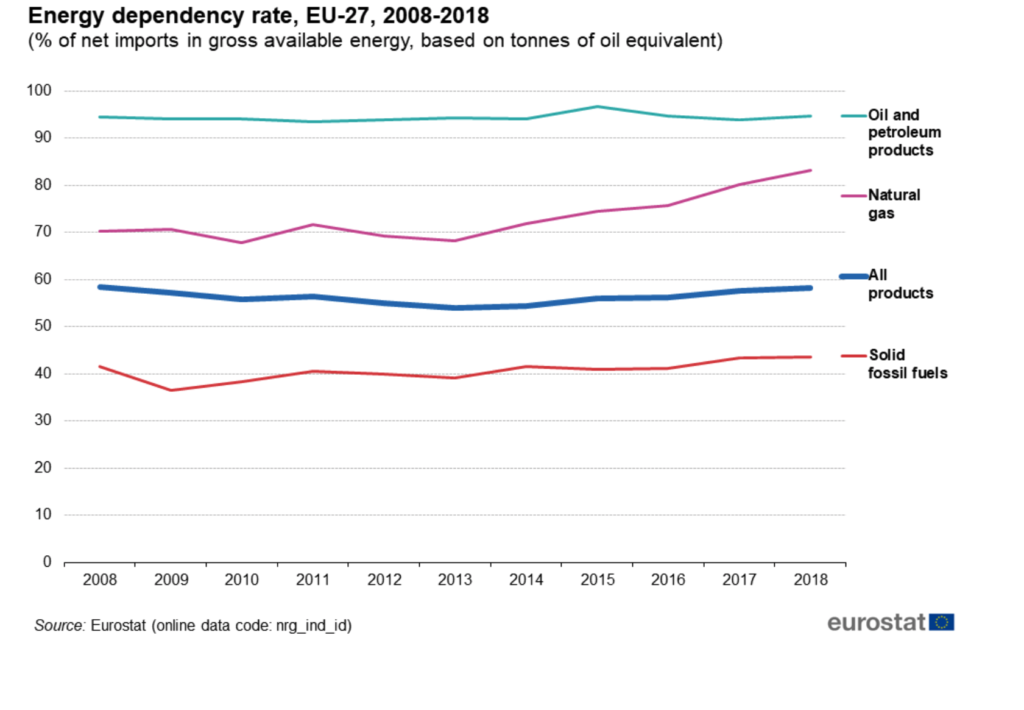It is called REPowerEU and it is the European plan to generate a sounder and energetically independent economy. The Commission is implementing it and its definition is expected by the end of May.
Did we really need a war outside the city to assign, in the political and public debate, the first place to the urgency of making the European economy more independent energetically? The European Union is a continent made up by 27 States, 447.7 million people, which grounds its energy provisioning by about 60% on raw materials imported from abroad. And what foreign Countries! Concerning gas, the EU imports 90% of what consumes and Russia supplies around 45% of it, in variable percentages among the various member States. Approximately 25% of oil imports and 45% of coal imports come from there, too. Europe is highly blackmailable. And this plays (also) against its negotiation force for peace, besides being a sword of Damocles on the head of all citizens and of the whole industry in Europe. For this reason, on March 10th and 11th, EU leaders have adopted the declaration of Versailles concerning also the need of decreasing energy addictions. The Commission was invited to propose the REPowerEU plan, which designs a path for the Union to reach the goal of independence and diversification of energy sources, especially of gas.

REPowerEU: the European actions for independence
• More renewable gas
Among the ways to diversify gas provisioning, a rise of the biomethane production is indicated, too. The current “Fit for 55” programme, the package of measures defined in July 2021 to reach Green Deal targets by 2030, provides that 17 billion m3 are produced within 2030. REPowerEu enhances the ambition and plans to produce 35 billions still within 2030. Biomethane is a renewable and programmable energy source that is produced from agricultural biomasses (dedicated crops, by-products of agri-food processing and zootechnical wastewaters) or from the organic fraction of municipal solid waste (OFMSW). Raw biogas is obtained from the anaerobic digestion of these biomasses, that is to say a mixture of CO2 (about 44%), biomethane (around 55%) and some impurities like H2S. Through a process known as upgrade, the biomethane is separated from CO2, both are purified from eventual impurities and both used. The following question remains: what happens with the CO2 derived from the upgrade of the biomethane biogas? The characteristics of this CO2 are optimal: according to some scientific studies and experiences on the field, it reaches the 99% purity in volume and it is chemically and microbiologically suitable not only for the Beverage food industry but also for being used as refrigerant R744.
• Strengthening the hydrogen production
To diversify sources, REPowerEu also aims at increasing the hydrogen use. With the current Fit for 55 programme, the EU aims at producing 5.6 million tons of renewable hydrogen by 2030. With REPowerEu, the issue is adding 15 million tons of renewable hydrogen by 2030 to those already foreseen and with this quantity it will be possible to replace yearly 25-50 billion m3 of imported gas. The refrigerated transport might benefit from a larger hydrogen diffusion, too.
• Heat pumps to electrify Europe
To break free from the dependence on fossil fuels more rapidly, it is necessary to electrify also the cooling and heating sector, more spreading heat pumps, simultaneously with a rise of the renewable electric production from sun and wind. With the proposals of the “Fit For 55” package, the photovoltaic and wind capacities of the EU are expected to double within 2025 and to triple within 2030, generating a saving of 170 billion m3 of gas on the yearly consumption by 2030.
If the diffusion of photovoltaic solar systems on roofs is intensified up to producing 15 TWh, this year the EU might save further 2.5 billion m³ of gas.
By doubling the annual planned installation rate of heat pumps, the appliances installed in the EU during next five years would become 10 millions, which would be equivalent to a gas saving amounting to 12 billion m3 every 10 millions of domestic heat pumps installed. To accelerate the marketing of heat pumps, it will be necessary to enhance quickly the whole chain and to introduce measures aimed at promoting building renovations and the upgrade of district heating systems.
• Decarbonizing industry and going on pursuing the energy efficiency
REPowerEU plan intends to accelerate the diffusion in industrial sectors of innovative solutions based on hydrogen and of competitive renewable electric energy in terms of costs. The Commission will anticipate the implementation of the Innovation Fund, to favour the shift to electrification and to hydrogen, also through a Union contract regime by difference on carbon, and to strengthen EU’s production capacities for the manufacturing of innovative appliances with zero and low carbon emissions, such as electrolysers, state-of-the-art sun/wind power technologies and other technologies. Finally, it is worth underlining the importance of all energy efficiency measures, an “ever green” solution to be pursued irrespective of primary sources used.




